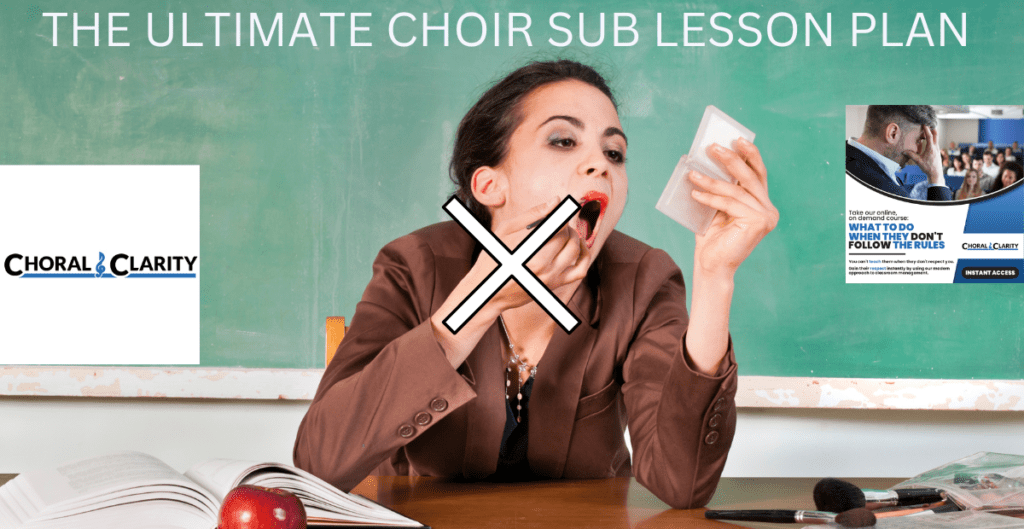In this blog, I’m going to introduce the ultimate substitute teacher choral lesson plan.
What makes this the ultimate plan?
- A non-music sub can administer it
- It can be used over and over again
- It can be used individually and as a small group project
- It will benefit your singers
- It can be graded, if needed
- It will be considered a legitimate plan by your administrators
Introducing: The YouTube Video Choir Assessment – here’s the gist of it
Put on a specific video of a choir performance for your singers to watch and evaluate. Set clear criteria for them to use. Pick a video that applies to your current repertoire. An example would be a video of another choir performing a song your choir is currently working on. Next, set criteria for your ensemble to evaluate.
Microsoft Office 365 is a subscription-based service, and it doesn’t offer a completely free version. However, Microsoft does provide free trials for Office 365, allowing users to test the software before committing to a subscription.
YouTube Video Choir Assessment – the details
First off, it’s always important that if you put on a recording, whether audio only or video, your students are focused on specific aspects of the recording. Simply playing a recording without direction leads to either: singing along or like/hate judgment. Instead, we want students to focus on different aspects of choral music-making. Each aspect needs to be clearly spelled out. Here are the categories I suggest using:
| Tone – overall sound of the group was beautiful and consistent |
| Balance/Blend – all voices and sections were unified and appropriately distributed with sound |
| Vowels – all vowels were consistently aligned, pure, and beautiful |
| Consonants – consonants were crisp, well articulated, and words were easy to understand |
| Dynamics – ensemble exhibited a varied range of volume that enhanced the performance and supported the interpretation |
| Rhythmic Integrity – ensemble remained together rhythmically, beginnings and ends of phrases, cutoffs, consonants in the right place, and a steady pulse whenever intended |
| Phrasing – the shape of each phrase or musical line provided vocal expression and interest |
| Interpretation – the style was culturally and musically appropriate, sung with emotion, and easy to connect to |
| Visual Expressions/Stage presence – ensemble was interesting to watch/connected to the music, each other, the conductor, and the audience |
Preparing for a sub:
I suggest if you are going to give this out as a sub plan, first use this in class as a teacher-led lesson. This is where you can teach each category separately. I recommend teaching this by playing the same recording 9 times, each time focusing on one specific category, followed by a brief class discussion.
Before I explain how to use it, I would like to give to share my Choir Video Performance Evaluation with you for free. At checkout, use code: SUBVIDEOLESSON and there will be absolutely NO CHARGE (through 10/24)!
Example
Let’s discuss “tone”. This is the overall sound of the group. Is it pleasing to the ear from start to finish? We aren’t discussing how clear the words are, or if the piece is interesting. All we are focused on is the beauty of the sound. After listening to the short choir video, first rate this category:
- 5 – outstanding
- 4 – good
- 3 – ok
- 2 – unacceptable
Next, we will discuss WHY you felt that way; this is where they can briefly write a comment.
Afterwards, you move to the next category and briefly explain it. Listen to the same recording again and evaluate that category.
The sub plans
Once your students understand this lesson and the process, all a sub needs to do is hand out the Choir Video Performance Evaluation form, play the recording of your choosing, and verbalize each category before repeating the recording each time. I believe that in many well-run choral programs, a student leader could run the lesson while the sub sits and observes from the sideline.
Helpful in-class deviations – breaking up into groups
When teacher-led, it’s easy to lead a group discussion after focusing on each specific category. When a sub is in charge, I do not recommend this. An alternative idea with a sub could be having the students break into small groups and discussing individual category after each focusing listening. One leader could be in charge. This approach could be used with a collective group evaluation by 2-4 students or where each student submits their own final assessment.
YouTube Homework assignment
This evaluation can be a great homework assignment. Of course, it’s far less likely that a student will be as thorough. They will likely not listen 9 times to the same recording. Even so, there is a lot to be gained by listening to a recording and assessing each individual aspect of a performance.
Download our Choir Video Performance Evaluation for free (until 10/24).
Evaluate your own choir’s performance, post concert!
You can even use this to evaluate your own choir’s video performance. Too often, teachers just play the performance for their student the day after the concert. If you believe this is important, perhaps focus on one song at a time and teach your students to listen critically. You can even match this lesson with the post concert self-assessment, which evaluates big picture aspects of the concert along with their own self-assessment of individual and collective aspects of their performance.

